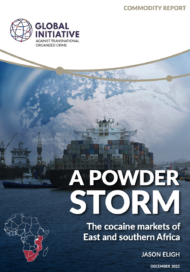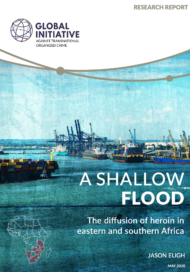Posted on 15 Dec 2022
There is a transition occurring in the production and distribution of cocaine.
Despite the extensive population containment and control measures put into place across the globe in the wake of the COVID-19 pandemic, the flow of cocaine powder from Latin America to global markets appears to have been largely uninterrupted. This is despite the fact that measures to significantly reduce supply have been put in place by the governments of Colombia – a country that is still the primary cultivator of coca – and the United States, the primary progenitor of and ally in the war on drugs.
The markets and supply chains for cocaine, as well as other illicit drugs, have proven to be remarkably resilient in the face of the growing patchwork of restrictions on movement and transport since March 2020 in the wake of the COVID-19 pandemic. The many predictions by experts of supply chain disruption to drug flows and the potentially disruptive impact of this on consumer markets have not come to pass. Cocaine distribution networks and related agents quickly found ways to bypass challenges raised by lockdowns and restrictions. Coca cultivation and potential cocaine production even expanded during the first year of the pandemic, reaching record or near-record levels in the three primary cultivation countries of the Andean production region.
Recently, a change has been observed in the prominence of international destination markets for cocaine. There has been a growing shift away from the US as the destination market of choice towards supplying domestic markets in Europe. This has been enabled by maritime and air supply chains that allow the efficient movement of com-modities direct to European Union (EU) ports and cities, but also through an apparent resurgence of traffic through indirect transit supply routes in the African countries along the Atlantic coastline, which are vulnerable to exploitation and well located for transit from other regions. While the West African state of Guinea-Bissau has long been a prominent player in the transit of cocaine from the Andean region of South America to Africa, and has been tagged as a narco-state because of its illicit drug trade dynamics, the story of cocaine in Africa today extends well beyond this country and its regional neighbours.
The expanding cocaine markets of East and south-ern Africa are starting to play an important role in the transnational flow of cocaine. This region has generally been viewed by analysts as being peripheral to transit trade relative to the amount of cocaine that is believed to move through West and North Africa annually, based partly on the volumes of cocaine that have been seized in those regions. However, information is emerging to suggest that this is not the case. The region’s growing popularity as a transit route is bolstered by capable but poorly monitored coastal container port facilities, weak marine enforcement capacity, political environments that favour illicit traders, and established maritime and air links to the destination markets of the EU, West Asia, East Asia and Australia.
As these countries become more prominent as transit points for cocaine, the use of the drug in their local markets increases. The seizure of more than five tonnes of pressed cocaine in South Africa in 2021, while implied to be in transit to international markets, has raised questions about the size and characteristics of domestic cocaine markets.
Generally, East and southern Africa has been regarded as being a predominantly cannabis-consuming region, with some established demand for opiates (particularly heroin) and a geographically limited demand for synthetics (particularly meth-amphetamine). Yet, with some notable exceptions, there has been a dearth of relevant, recent analysis of domestic drug markets across the region to refute (or substantiate) these basic presumptive analyses.
This is not a surprise to some observers. After all, it is well known that most national governments in the region do not have adequate capacity to generate the data to monitor and understand drug markets in their jurisdictions. This not only dimin-ishes the ability of nations to design and implement an evidence-based response to the structures and characteristics of their illicit drug markets, but also prejudices the international and regional monitoring systems and tools that rely on such national data for collective analysis and threat projection. There remains a belief also among some drug intelligence experts and agencies that the content and structure of these markets still can be analyzed using arrest and seizure statistics, however fragmented and unreliable they may be.
Recent assessments of domestic drug markets in the region have demonstrated that some of the established knowledge about them tends to be premised largely on outdated, irrelevant, or poorly understood data. This has, in turn, led to potentially biased observations and the formulation of inaccurate assumptions and conclusions in the threat analyses of external analysts. In fact, many countries in the region themselves suffer from similar gaps in their national surveillance schemes, affecting their comprehension of their own domestic drug markets.
The purpose of this report is to explore the current retail markets for cocaine across a number of countries in East and southern Africa. This is achieved by analyzing cocaine availability, retail pricing and distribution systems for domestic markets. The analytical summary of cocaine markets in the report is drawn from a series of fieldwork exercises across 16 countries in this region.
Data contributing to the analysis includes the identification of specific domestic retail market price points for cocaine; interviews to uncover details of domestic cocaine use, distribution systems and structures; and discussions with market participants of the common structural characteristics across the region that enable and sustain these markets.
The countries examined are Botswana, Comoros, Eswatini, Kenya, Lesotho, Madagascar, Malawi, Mauritius, Mayotte, Mozambique, Réunion, Seychelles, South Africa, Tanzania, Zambia, and Zimbabwe. Previous research has examined the flow of both heroin and meth in the region, examining these illicit drug flows and the potential for them to sustain and entrench existing domestic markets. It has also assessed the structural characteristics of existing markets as well as the factors that contribute to the development of new consumer markets. The current research has a similar focus, looking exclusively at issues related to the cocaine market.




